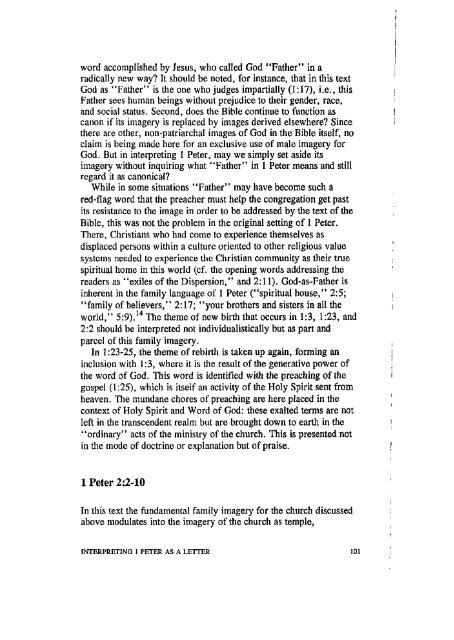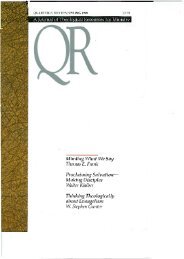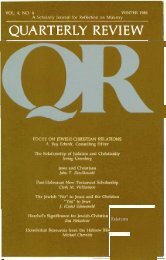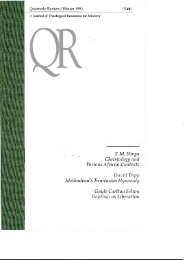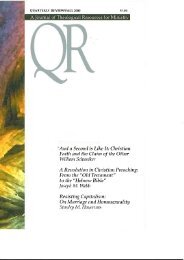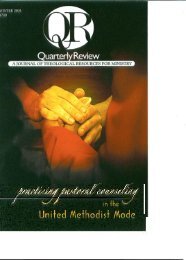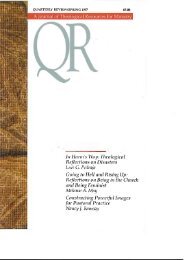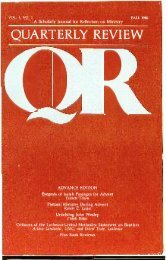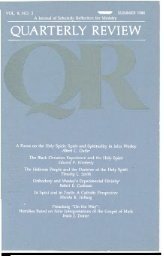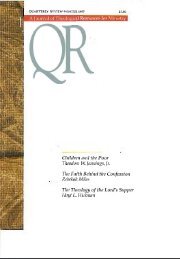TJieodore W. Jennings, Jr. The Meaning of ... - Quarterly Review
TJieodore W. Jennings, Jr. The Meaning of ... - Quarterly Review
TJieodore W. Jennings, Jr. The Meaning of ... - Quarterly Review
Create successful ePaper yourself
Turn your PDF publications into a flip-book with our unique Google optimized e-Paper software.
word accomplished by Jesus, who called God "Father" in a<br />
radically new way? It should be noted, for instance, that in this text<br />
God as "Father" is the one who judges impartially (1:17), i.e., this<br />
Father sees human beings without prejudice to their gender, race,<br />
and social status. Second, does the Bible continue to function as<br />
canon if its imagery is replaced by images derived elsewhere? Since<br />
there are other, non-patriarchal images <strong>of</strong> God in the Bible itself, no<br />
claim is being made here for an exclusive use <strong>of</strong> male imagery for<br />
God. But in interpreting 1 Peter, may we simply set aside its<br />
imagery without inquiring what "Father" in 1 Peter means and still<br />
regard it as canonical?<br />
While in some situations "Father" may have become such a<br />
red-flag word that the preacher must help the congregation get past<br />
its resistance to the image in order to be addressed by the text <strong>of</strong> the<br />
Bible, this was not the problem in the original setting <strong>of</strong> 1 Peter.<br />
<strong>The</strong>re, Christians who had come to experience themselves as<br />
displaced persons within a culture oriented to other religious value<br />
systems needed to experience the Christian community as their true<br />
spiritual home in this world (cf. the opening words addressing the<br />
readers as "exiles <strong>of</strong> the Dispersion," and 2:11). God-as-Father is<br />
inherent in the family language <strong>of</strong> 1 Peter ("spiritual house," 2:5;<br />
"family <strong>of</strong> believers," 2:17; "your brothers and sisters in all the<br />
world," 5:9). 14<br />
<strong>The</strong> theme <strong>of</strong> new birth that occurs in 1:3, 1:23, and<br />
2:2 should be interpreted not individualistically but as part and<br />
parcel <strong>of</strong> this family imagery.<br />
In 1:23-25, the theme <strong>of</strong> rebirth is taken up again, forming an<br />
inclusion with 1:3, where it is the result <strong>of</strong> the generative power <strong>of</strong><br />
the word <strong>of</strong> God. This word is identified with the preaching <strong>of</strong> the<br />
gospel (1:25), which is itself an activity <strong>of</strong> the Holy Spirit sent from<br />
heaven. <strong>The</strong> mundane chores <strong>of</strong> preaching are here placed in the<br />
context <strong>of</strong> Holy Spirit and Word <strong>of</strong> God: these exalted terms are not<br />
left in the transcendent realm but are brought down to earth in the<br />
"ordinary" acts <strong>of</strong> the ministry <strong>of</strong>the church. This is presented not<br />
in the mode <strong>of</strong> doctrine or explanation but <strong>of</strong> praise.<br />
1 Peter 2:2-10<br />
In this text the fundamental family imagery for the church discussed<br />
above modulates into the imagery <strong>of</strong> the church as temple,<br />
INTERPRETING 1 PETER AS A LETTER 101


